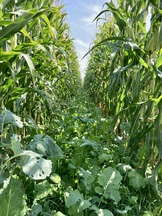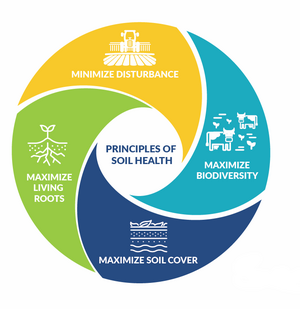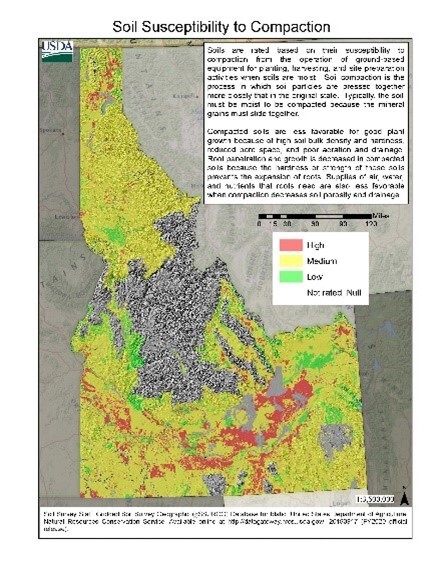|
Hello! We are Courtney Cosdon (University of Idaho Extension/Natural Resources Conservation Service) and Tasha Harder (NRCS Idaho), bringing you Idaho soil health news and information. In this newsletter, we are sharing resources to encourage the use of soil health practices and working to involve more of our community in soil health events and discussions.
-
June 25 – University of Idaho (U of Idaho) Snake River Weed Management Tour and Field Day, Aberdeen Research and Extension Center (R&E). Registration 8 to 9 a.m., tour from 9 a.m. to noon, lunch served. No preregistration required. Pesticide credits available. Contact: Pam Hutchinson, phutch@uidaho.edu
-
June 26 – U of Idaho Snake River Weed Management Tour and Field Day, Kimberly R&E Center. Registration 8 to 9 a.m., tour from 9 a.m. to noon, lunch served. No preregistration required. Pesticide credits available. Contact: Albert Adjesiwor, aadjesiwor@uidaho.edu
-
July 17 – Twilight Tour, Aberdeen R&E Center, 5 to 8 p.m. Contact Chad Jackson at 208-844-6316 or chadj@uidaho.edu.
-
Mid July – Field Day with Ladd Wahlen, Aberdeen, ID. Discussions will include minimum tillage in potato production, integrating cattle, cover cropping and more. More details to come.
-
End of July – Third Impromptu Field Day with Blake Matthews, in Burley, ID. More details to come.

The Idaho Chapter of the Nature Conservancy’s goal is to bring people together to drive transformational change and tackle the biggest conservation challenges facing people and nature. In 2018, The Nature Conservancy (TNC) launched its Healthy Soil, Resilient Waters program – whose aim is to advance regenerative farming practices across the state by lowering the barriers to adoption. TNC believes that improved farming practices that focus on improving soil health and reducing water demands will lead to reductions in climate emissions, improve water quality, reduce water demands and create more resilient farms and communities. Through technical and financial support, knowledge sharing and partnerships with public and private organizations, TNC-Idaho is trying to build the infrastructure necessary to achieve wide-spread adoption.
|
Impromptu Field Days
Impromptu field days are quick, educational field visits to see and discuss a soil health practice that a producer is trying on their land. If you would like to host an impromptu field day and have your neighbors out to your place for a couple hours, please contact Courtney Cosdon ccosdon@uidaho.edu, (208) 364-4692
Innovative Agriculture and Marketing Partnership (IAMP-Idaho) Grant
The University of Idaho has secured a $55 million USDA-NRCS grant to help farmers adopt climate smart practices on Idaho’s major commodity crops including potatoes, barley, beef, chickpeas, hops, sugar beets and wheat. Do you grow any of these crops? Are you interested in incorporating practices such as cover cropping, reduced tillage, interseeding, nutrient management for reduced nitrogen applications, biochar or grazing cattle on grounds managed using these practices? Would you like to have funding to help with the costs and risks of adoption? If so, you may be interested in this program.
Here's what you can do to get started:
-
Stay tuned to the IAMP-Idaho Website
-
Talk to representatives of any of the implementing groups. These include: your local Soil and Water Conservation district representative, The Nature Conservancy, Nez Perce or Coeur d’Alene Tribal representative, or Desert Mountain Grass fed Beef.
Early adopters and long-time practitioners of one or more of these practices are encouraged to apply. Both smaller and larger farms are welcome.
NRCS Programs Dates
The Environmental Quality Incentives Program (EQIP) provides technical and financial assistance, to producers who want to address resources concerns and implement conservation practices on their land. Call your local NRCS field office to schedule a meeting.
- EQIP signup deadline: October 4, 2024
Conservation Stewardship Program (CSP) helps landowners build upon conservation efforts already in place, while increasing resilience of the operation. CSP pays landowners for conservation performance. Call your local NRCS office to learn more!
- CSP signup deadline: February 28, 2025
Older editions of the Soil Health Minute can be found on the University of Idaho Soil Health website, under the News & Events tab.
A two-year study from Linda Schott (Uof Idaho) and team, Kimberly R&E Center
In this two-year study, U of Idaho Extension researchers trialed five biostimulant products on corn silage. The objective behind this research was to determine if the product claims of increasing yield and nutrient use efficiency, while improving soil health are true. The biostimulants chosen for the study were based on feedback from stakeholders to replicate products that producers are being marketed and which are locally available. The study found that overall products did not seem to have strong impact on the chosen crop or soil health. Check out the paper for more details and to learn which products were used.
Heglar Creek Farms, ID – Soil Health Case Study
American Farmland Trust (AFT) completed a second soil health economic case study here in Idaho. This case study features Heglar Creek Farms in Cassia County, and it has been calculated that Kurt Heward has achieved a whopping 309% return on investment. Keep an eye out for an invitation this Fall from Regenerative Agriculture Network of Idaho (RANI) to learn more about the study results.

|

One of the four NRCS principles of soil health is to maximize biodiversity. This can be achieved through incorporating more crops into a rotation, using multispecies cover crops with plants from different families and with different rooting structures, and by incorporating grazing animals into the cropping system. Maximizing soil biodiversity is hugely important for improving the overall function of soils.
This recent publication links soil biodiversity to improving soil aggregation by giving concrete examples of how different organisms benefit soil aggregation in different ways.
-
Soil fungi mostly contribute to the development of macro-aggregates, whereas soil bacteria are important contributors to aggregation at the micro and macro scale.
-
Microbes with different growth forms (for example, filamentous versus unicellular) interact differently with the environment via their body surface and have different influences on soil aggregation.
-
Nonmotile bacteria have a larger effect on soil aggregation than motile bacteria because they stay in one place and allow biotic glues to accumulate in a localized area to effectively stabilize soil particles.
-
There are three different groups of earthworms that live, feed, and affect soil properties differently. The endogeic group of earthworms most positively affects soil aggregation; these earthworms live in the upper part of the soil and create horizontal burrows.
-
Diversity across different taxa more positively affects soil aggregation than diversity within the same taxon.
Strong, stable soil aggregation improves the function of soils by maintaining abundant pore space between aggregates, improving gas exchange, water infiltration and water storage in the soil profile. That pore space also serves as habitat for the organisms that further build and improve soil aggregation. Other soil health principles are directly connected: to protect diverse communities of microbes it’s important to reduce disturbances to their habitat, and to continually feed these populations with crop residues and exudates from living plant roots.
|

The Idaho NRCS Soil Health web page has a collection of soil health maps that display a statewide view of soil conditions or susceptibility to degradation based on the soil properties. These maps were developed using NRCS soil survey data.
The ratings on the Soil Susceptibility to Compaction map are based on soil properties in the upper 12 inches of the profile, including soil texture, organic matter content, structure, rock fragment content, and the existing bulk density.
Map credit: Shanna Bernal-Fields (NRCS)
|
 |
|
NRCS Idaho
9173 W Barnes Dr, Suite C
Boise, ID 83709
Phone: 208-378-5700
|
|